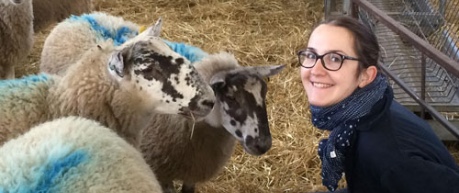Wednesday 29th November 2017, 12:00pm
People's inability to tell the difference between a happy sheep and an unhappy sheep is the subject of a famous joke in Father Ted, but a new study has revealed that the animals can distinguish each other's facial expressions.

In what is being seen as an important discovery in terms of animal welfare, researchers at Scotland's Rural College (SRUC) found that facial expressions are a key social signal that can affect cognitive processes in small ruminants, such as sheep, goats and deer.
The study, which was carried out in association with the French National Institute for Agricultural Research (INRA), found that sheep can distinguish between negative and neutral facial expressions in other sheep. Compared to primates, sheep do not have a very developed oro-facial musculature, however they are able to displace a wide array of facial expressions, especially involving ear postures.
It is thought that, if animals are able to perceive emotions in others,
then it is likely to affect their own emotional state. The findings of
the experiment, led by Dr Lucille Bellegarde, have been published in the
academic journal Frontiers in Veterinary Science.
"This study showed for the first time that sheep are not only able to discriminate between facial expressions, but they are also able to perceive the valence - in other words, negative or neutral - of the expressions displayed. In terms of animal welfare, it is essential to be able to understand how emotions are perceived between animals reared in groups."
"Because this emotional perception is likely to affect their own emotional state, it might take just one happy - or unhappy - sheep to make an entire flock happy, or unhappy."
As part of the study, sheep were photographed in three situations. To obtain neutral expressions, they were photographed in their home pens and, for negative expressions, they were either photographed during social isolation, or during aggressive social interactions.
The sheep were then trained in a simultaneous visual discrimination task, where the animals had to associate one type of facial expression with a reward. Half of the sheep had to learn to associate the image of a negative facial expression with the reward, and the other half had to associate the image of a neutral expression with a reward.
Once they had learned the task, sheep then had to generalise the discrimination to new images of faces, displaying the same emotions. All sheep managed to learn the discrimination task with images of faces, showing that sheep are able to discriminate between facial expressions.
The results also showed that sheep that had to learn to associate the image of a negative facial expression with a reward learned faster than sheep that had to learn the neutral face reward association.
"We have linked this difference to the attention bias that exists in mammals towards negative stimuli. For instance, humans pay more attention to potential threat such as images of spiders, than to images of buildings. This increased attention towards images of negative faces is most likely what 'helped' the animals to learn the discrimination task more quickly."
Dr Bellegarde studied at SRUC, with her PhD awarded through the University of Edinburgh.
Source: SRUC